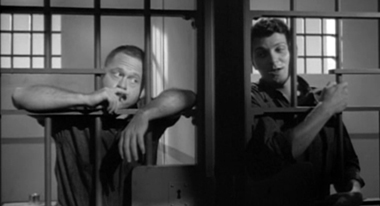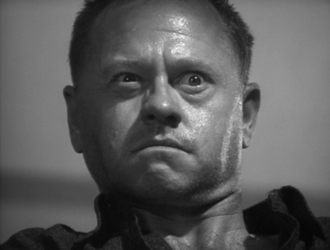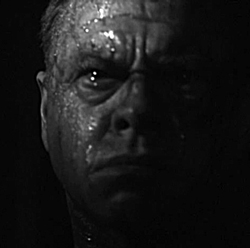
 |
|
|
|
Writer John Wexley began his career with the Broadway play The Last Mile. The 1932 film adaptation diluted Wexley's hard-bitten tale of desperate convicts staging a breakout from Death Row, adding a subplot that made the leading character an innocent victim of imperfect justice. But he was launched on a successful fifteen-year career as a Hollywood screenwriter. Wexley scripted and co-scripted the James Cagney films Angels with Dirty Faces, The Roaring Twenties and City for Conquest. He quickly became known for movies with an anti-Fascist agenda, and spent much of his time in union organizing. Wexley was blacklisted almost from the outset of the HUAC committee's march through the Hollywood talent roster, but his name turned up twelve years later in one more Hollywood title sequence, for a remake of The Last Mile, produced by Max Rosenberg and Milton Subotsky for United Artists. 
Milton Subotsky took a screenwriting credit with Seton I. MIller for the new adaptation, which retains the play's closed environment of the Death Row cellblock. The 1959 The Last Mile is unlike most of United Artist's underfunded B&W films from the late 1950s. It was built around the star presence of Mickey Rooney, then at the end of a decade-long effort to establish himself as a major dramatic actor. After leaving MGM, Rooney had kept busy in starring parts in films and TV, many of them crime pictures. But top roles eluded him. Critics persisted in charging him with overacting. This remake concentrates not on the new occupant of Death Row, but instead on the utterly ruthless, nihilistic "Killer" Mears (Rooney). Time is running out for Mears' seven or eight fellow condemned prisoners each stewing in his own cell. Ed Werner (Michael Constantine) has clearly gone insane, but is scheduled for the electric chair just the same. Red Kirby (Ford Rainey) was granted a last-minute stay of execution, and is looking for another opportunity for a delay. The story opens with the new arrival watching as another is escorted out the "mystery door". A few seconds later the lights dim as the voltage is re-routed to the electric chair. It's possible that the movie was made to cash in on Robert Wise's recent anti- death penalty hit I Want to Live!, for which Susan Hayward earned a Best Actress Oscar. Perhaps influenced by that picture, more than one contemporary review decided that The Last Mile was a similar statement against the death penalty. But any social message is secondary to the film's display of savage desperation. The condemned have no reason not to strike out against their captors, and certainly nothing to lose. 
Underplayed though they may be, the guards working the Death House are definitely the "lousy screw" stereotypes of John Wexley's 1930 original. Drake (Don "Red" Barry) sneers at his captives, making fun of their predicament and reminding them that they're all going to die. The man in charge of the block is the Warden's brother-in-law, Callahan (Leon Janney). He bears a personal grudge against Mears. This official attitude carries over to the other guards. Harris (Clifton James, the future "Sheriff Pepper" of two James Bond movies) lords it over the nervous condemned inmates, a perpetual grin on his face. The insults and bad blood are of course part of a buildup to the big breakout. The unpredictable Mears reaches through the bars, gets a neck-lock on Drake and frees his compatriots. They capture all the guards, including supervisor Callahan. Although they can't leave the block without walking into a fusillade of bullets from the guard towers, Mears and his cohorts avail themselves of a cache of weapons and ammunition (conveniently located inside the Death House) and the mayhem begins. The Last Mile hit television early in the 1960s and immediately became a topic of discussion on the playground. None of us fourth graders had ever seen anything so ruthless. Mears threatens to shoot one of the guards in the face, and, hardening his face to a granite stare, does it without hesitation. From that point on the film is a pitched battle. The Warden cannot give Mears the car he demands, and Mears keeps threatening to kill more guards. Police bullets cut down more inmates, as well as a terrified prison employee (Milton Seltzer) caught in the death house. In a nice bit of irony, Harris whines and begs for his life, imploring Mears to murder older guard O'Flaherty (Frank Conroy) in his place. O'Flaherty agrees to sacrifice himself -- and then Mears simply sends him out to carry a personal message to the Warden. 
The film's one recourse to decency or convention (choose one) is to have Jimmy Martin (John Vari) restrain Mears from executing the prison priest, played with sober conviction by second-billed Frank Overton. Other than that, The Last Mile is fairly uncompromised. The action remains confined almost exclusively to the one cellblock, but producers Rosenberg and Subotsky compensate with a lot of shoot-out action in which bullets carve holes in the cinderblock walls and scatter fragments of concrete everywhere. Sam Peckinpah may have been impressed by several bits of action: when a guard is pushed out the front door of the cell block, he's met by a hail of bullets from the guard tower, despite being uniformed and holding his hands up. Mears also performs a mercy killing on one of his men. The question for opinionated critics is whether Mickey Rooney delivers a powerful performance, or is chewing scenery. I'm in favor of the first interpretation, personally. The script needs Killer Mears to be a snarling hothead with a big hate-on for the guards, the Warden and the whole damn world. I've seen Rooney underplay scenes beautifully, and I've also seen pictures where he's seemingly left to his own devices (The Secret Invasion, Pulp) and overdoes it. I like the way he pitches Killer Mears. He doesn't simply pull faces, and his eye twitches in the giant sweaty close-ups seem wholly appropriate. Rooney's Mears is a few notches past Cody Jarrott on the psycho scale, and he's pretty scary. Rooney may have had a hand in choosing the director, as Howard W. Koch had just directed Rooney's uneven Andy Hardy Comes Home. The rudimentary camera blocking is effective in the stark death house setting, and always attuned to Rooney's performance. It's altogether possible that Rooney had some influence over that. 
Other New York actors playing condemned men battling with the guards are Clifford David, Harry Millard, John McCurry and Pete Rodriguez. I was looking forward to the performance of Johnny Seven, who plays the tough cab driver who punches out Jack Lemmon in The Apartment. Unfortunately, Seven isn't given any particularly good moments to show what he can do. The MGM Limited Edition Collection DVD-R of The Last Mile is a quite good plain-wrap presentation. The transfer is just fine, although presented open-matte 1:33. Were it properly enhanced at 1:85 the tighter compositions would spare us a lot of views of floors and ceilings, and more sharply focus Mickey Rooney's "dynamo in a nutshell" performance. The title sequence uses jazz music and an animated lettering design, in search of a "Saul Bass" look. If The Last Mile were filmed a year later, I'd say that the photo on the disc box had been staged to look like a scene from Spartacus, with Mickey Rooney leading his fellow gladiators to freedom.
On a scale of Excellent, Good, Fair, and Poor,
The Last Mile rates:
Reviews on the Savant main site have additional credits information and are often updated and annotated with reader input and graphics. Also, don't forget the 2011 Savant Wish List. T'was Ever Thus.
Review Staff | About DVD Talk | Newsletter Subscribe | Join DVD Talk Forum |
| ||||||||||||||||||